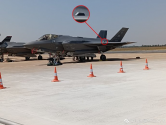Ongoing headaches with F-35 fighter jets are rippling through the rest of the US military's combat aircraft fleet
Michael Peck
Jan 12, 2023, 6:09 PM
- The F-35 program has been plagued by years of delays, cost overruns, and technical glitches.
- Those problems have prompted the Pentagon to extend the service lives of older combat jets.
- Extensions keep jets flying but don't guarantee they will meet future needs, a government watchdog says.
Top editors give you the stories you want — delivered right to your inbox each weekday.
By clicking ‘Sign up’, you agree to receive marketing emails from Insider as well as other partner offers and accept our and .
Years of delays, cost overruns, and technical glitches with the F-35 have put the Pentagon in a dilemma.
If F-35s aren't fit to fly in sufficient numbers, then older aircraft such as the F-16 must be kept in service to fill the gap. In turn, having to extend the lifespan of older planes consumes money that could be used to acquire new aircraft and results in aging warplanes that may not be capable of fulfilling their missions on the current battlefield.
"While service life extension programs are one way to keep current aircraft capable and in operation, they do not guarantee that those aircraft will be available when needed or that they will possess required capabilities to meet future needs," the in a new report on US tactical aircraft.
The F-35 is meant to be the backbone of the US Air Force, Navy, and Marine fighter fleets, replacing several types of Cold War-era fighters and attack aircraft, including Navy and Marine F/A-18 C/Ds, Marine AV-8Bs, Air Force A-10s, and, most importantly, Air Force F-16s, which are the US's most numerous fighters.
F-35As and F-16s over Denali National Park in Alaska in May 2020. US Air Force/Tech. Sgt. Jerilyn Quintanilla
Despite making its first flight in 2006, the F-35 — which costs about $100 million apiece — still hasn't been approved for full-rate production and remains in limited procurement.
The aircraft has been plagued by a seemingly , including problems with its , sustained supersonic flight, helmet-mounted display, excessive vibration from its cannon, and even vulnerability to being .
The military and Lockheed Martin have resolved some of those problems, but the cumulative effect of the delays is that the Air Force has had to shelve plans for the F-35 to , which now will keep flying until the 2040s.
"Over the last decade the Air Force and Navy have funded service life extension programs for F-16s and F/A-18 A-Ds — both originally expected to be replaced by F-35 — to address fatigue of structural components and keep the aircraft capable and in operation," the GAO report said.
The remarkable longevity of some aircraft — such as the or the — tends to obscure the difficulty of keeping old warplanes flying. Production lines are usually shut down, and the original manufacturers of components and spare parts have long ceased production. In some cases, they are no longer in business.
US Air Force maintainers work on an F-35A at Nellis Air Force Base in Nevada in February 2020. US Air Force/R. Nial Bradshaw
Russia's air force has been mocked for its airpower in the Ukraine war. But the US military has also long suffered from major readiness shortfalls, as have NATO nations such as Germany. In 2020, fewer than 10 of the Luftwaffe's were operational.
Particularly troubling was a November 2022 GAO study that analyzed readiness of 49 US military aircraft models between 2011 and 2021.
"Only four aircraft types, none of which were fixed-wing fighter aircraft, met their annual mission capable goals in a majority of those years," the watchdog warned.
To some extent, this problem afflicts all modern military hardware. Complex weapons — whether fighters, tanks, or aircraft carriers — seem prone to reliability and maintenance issues or to shortages of specialized and expensive spare parts.
But the F-35 has become the poster child for aircraft readiness woes. An blamed that on a lack of spare parts, a lack of maintenance equipment, and on ground crews lacking the technical data they needed to maintain the aircraft.
A reassembled F-35A is hoisted during a training course at Hill Air Force Base in September 2022. Hill Air Force Base
The stakes are high. The Air Force, Navy and Marine Corps together plan to spend $20.2 billion a year for tactical aircraft development and procurement between now and 2027.
But the services are trying to allocate those funds between three competing needs: adequate numbers of aircraft and capabilities in the near-term, ongoing affordability issues, and preparing for future needs.
The Air Force's proposed 2023 budget already calls for delaying acquisition of 66 F-35s originally scheduled for 2023 until 2027, while the Navy is buying 31 fewer F-35s and delaying a service-life extension for the F-18E/F Super Hornet.
The GAO urged the Department of Defense to conduct a comprehensive assessment of its investments in tactical aircraft, including risk analysis and how the various aircraft programs depend on each other. But whatever happens, US airpower will be diminished until the F-35 is fully fixed.


